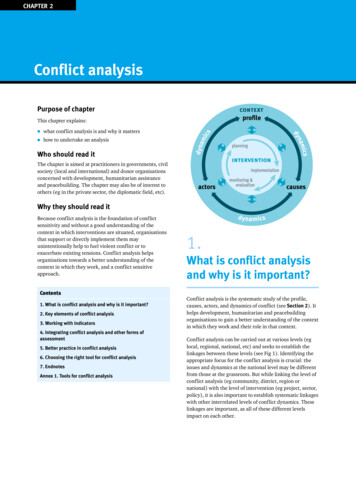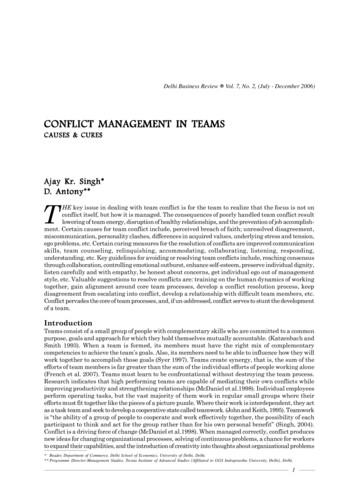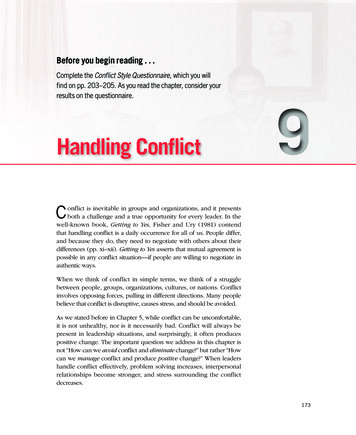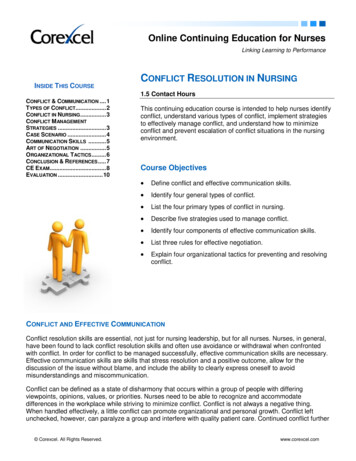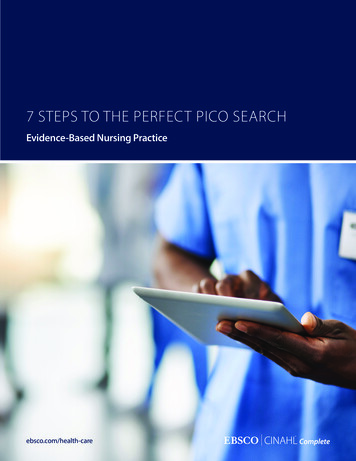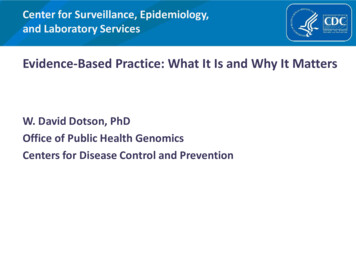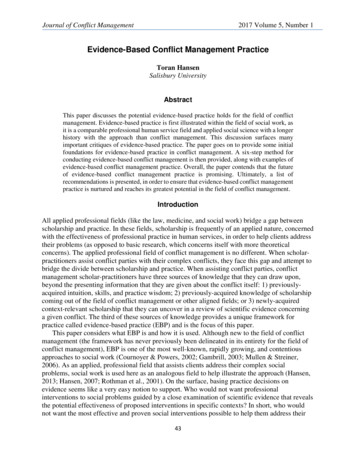
Transcription
Journal of Conflict Management2017 Volume 5, Number 1Evidence-Based Conflict Management PracticeToran HansenSalisbury UniversityAbstractThis paper discusses the potential evidence-based practice holds for the field of conflictmanagement. Evidence-based practice is first illustrated within the field of social work, asit is a comparable professional human service field and applied social science with a longerhistory with the approach than conflict management. This discussion surfaces manyimportant critiques of evidence-based practice. The paper goes on to provide some initialfoundations for evidence-based practice in conflict management. A six-step method forconducting evidence-based conflict management is then provided, along with examples ofevidence-based conflict management practice. Overall, the paper contends that the futureof evidence-based conflict management practice is promising. Ultimately, a list ofrecommendations is presented, in order to ensure that evidence-based conflict managementpractice is nurtured and reaches its greatest potential in the field of conflict management.IntroductionAll applied professional fields (like the law, medicine, and social work) bridge a gap betweenscholarship and practice. In these fields, scholarship is frequently of an applied nature, concernedwith the effectiveness of professional practice in human services, in order to help clients addresstheir problems (as opposed to basic research, which concerns itself with more theoreticalconcerns). The applied professional field of conflict management is no different. When scholarpractitioners assist conflict parties with their complex conflicts, they face this gap and attempt tobridge the divide between scholarship and practice. When assisting conflict parties, conflictmanagement scholar-practitioners have three sources of knowledge that they can draw upon,beyond the presenting information that they are given about the conflict itself: 1) previouslyacquired intuition, skills, and practice wisdom; 2) previously-acquired knowledge of scholarshipcoming out of the field of conflict management or other aligned fields; or 3) newly-acquiredcontext-relevant scholarship that they can uncover in a review of scientific evidence concerninga given conflict. The third of these sources of knowledge provides a unique framework forpractice called evidence-based practice (EBP) and is the focus of this paper.This paper considers what EBP is and how it is used. Although new to the field of conflictmanagement (the framework has never previously been delineated in its entirety for the field ofconflict management), EBP is one of the most well-known, rapidly growing, and contentiousapproaches to social work (Cournoyer & Powers, 2002; Gambrill, 2003; Mullen & Streiner,2006). As an applied, professional field that assists clients address their complex socialproblems, social work is used here as an analogous field to help illustrate the approach (Hansen,2013; Hansen, 2007; Rothman et al., 2001). On the surface, basing practice decisions onevidence seems like a very easy notion to support. Who would not want professionalinterventions to social problems guided by a close examination of scientific evidence that revealsthe potential effectiveness of proposed interventions in specific contexts? In short, who wouldnot want the most effective and proven social interventions possible to help them address their43
Journal of Conflict Management2017 Volume 5, Number 1social problems? However, when EBP is examined more closely, some of its more controversialdimensions emerge in sharp relief. As it is a new and unexplored practice framework in the fieldof conflict management, it will first be considered as an approach to social work, which iscurrently wrestling with many controversies stemming from the use of EBP. Social work istreated as a comparable profession here because it shares many theories and methods withconflict management, provides interventions for complex and diverse social problems at varioussocietal levels, and is practiced by professionals who work collaboratively with their clientele,using applied social science research (Hansen, 2013; Hansen, 2007; Rothman et al., 2001). Inaddition, many intervention models in both fields stress an analysis of needs, interests, values,narratives, and identity concerns within a wider socio-political context, with practitioners whooften employ problem-solving strategies (Rothman et al., 2001). Both fields are alsointerdisciplinary and draw scholarship from such fields as the law, psychology, sociology, andpolitical science (Hansen, 2007). Finally, research in both of these fields is firmly grounded inpractice, with both fields emphasizing evaluation research (Hansen, 2013).This outline of EBP illustrates a novel practice framework for conflict management,providing a helpful, structured means for bridging a gap between scholarship and practice thatcan be challenging for practitioners. Such a gap between scholarship and practice has been notedby a variety of scholars in the field of conflict resolution (for instance, Hansen, 2013; Irving &Benjamin, 2002; Mayer, 2004; Schellenberg, 1996). On the other hand, the use of EBP raises avariety of contentious and thought-provoking questions that may introduce new challenges forconflict management scholar-practitioners. While this reflection must be ongoing, this paperpresents a working model for conducting evidence-based conflict management practice, alongwith a set of recommendations to support its use and development within the field of conflictmanagement. Even though EBP presents conflict management scholar-practitioners with somechallenges, this paper contends that it holds a great deal of promise and should be nurtured.What is Evidence and Why is it Used?In order to clearly delineate EBP for the field of conflict management, the term “evidence” as itis being used here first needs to be defined. In applied, professional, human service fields likeconflict management and social work, what “evidence” means varies from context to context andis contested. At its most basic level, “evidence” is the information that practitioners and policymakers use to guide their decision-making (Grinnell & Unrau, 2011). In the legal field,“evidence” is forensic, constituting the material facts in a legal case that fit with various accountsor perspectives of an event (Davis, 2015). This evidence must hold up to legal standards, whichemerge out of social, normative, and authoritative frameworks designed to determine legal rightsand responsibilities in a given case (Davis, 2015). In the humanities, “evidence” constitutesinformation that comes from written and oral sources situated in specific social contexts, whichgive rise to concepts that are examined using moral and interpretive perspectives (Nelson, 1993).However, EBP emerges out of the tradition of the applied social sciences, so the scientificmethod is used to determine what constitutes the best “evidence” in a given practice context(Grinnell & Unrau, 2011). EBP scholar-practitioners use data that is derived from rigorousscientific studies as a foundation for making practice decisions (Rosenthal, 2006). This form of“evidence” must be demonstrably transferable to a specific social problem within a particularpractice context (by ensuring that the data relates directly to the social problem at hand and camefrom a comparable context) (Payne, 2005). This means that practice decisions cannot simply be44
Journal of Conflict Management2017 Volume 5, Number 1made based on practitioners’ intuition, philosophical bias, preferred techniques, orunsubstantiated opinions, but should instead be heavily influenced by a review of scientificevidence relating to a given case at hand (Grinnell & Unrau, 2011; Payne, 2005). This view of“evidence” places EBP scholar-practitioners squarely within the applied social sciences.How evidence is used in applied, human service fields is a critical consideration in EBP. Inconflict management, practitioners must make important decisions about interventions thatideally benefit their clients and ameliorate their complex social conflicts. When using EBP,evidence needs to be considered to determine if, how, and what type of interventions wouldideally suit and assist conflict parties (for instance, Clarke & Peterson, 2016; Hansen, 2013;Irving & Benjamin, 2002). In so doing, evidence in the form of research findings could helppractitioners to determine particularly relevant and effective theories (for example, socialidentity, narrative, or basic human needs theory), interventions (such as mediation, arbitration, orconflict coaching), practice models (for instance, the problem-solving, transformative, ornarrative approaches to mediation), and techniques (like reframing, active listening, or openended questioning) for specific conflict parties in their particular circumstances. Therefore, it isimportant that EBP scholar-practitioners understand a variety of conflict interventions andapproaches well, like a generalist (Hansen, 2013; Mayer, 2009; Schellenberg, 1996). If apractitioner is committed to a specific intervention or approach to practice, then conducting aliterature review and an assessment of evidence specific to a given conflict in order to betterunderstand the effectiveness of a variety of interventions or approaches would be unnecessary. Inthe field of social work, the consideration of possible interventions to assist clientele is called‘clinical decision-making’ and it is this clinical decision-making that is predicated upon a clientspecific review of the evidence in EBP (McCracken & Marsh, 2008).The Origins of Evidence-Based Practice in Social WorkThe term ‘evidence-based practice’ (EBP) emerged out of the medical profession and was coinedby a medical team at McMaster University in Canada, in the 1980s (Rosenthal, 2006). The fieldof social work took notice of EBP the following decade and the practice took hold after thepublication of a catalytic article entitled, “Should Social Work Clients Have the Right toEffective Treatment?” (Myers & Thyer, 1997). The underlying assumption of the article wasthat effective treatments for social problems can best be identified through rigorous scientificstudy. EBP therefore arose in social work to deal with the concern that social workers frequentlydo not use available scientific research as a basis for clinical decision-making (Mullen et al.,2008). Furthermore, many social workers felt that they had a duty to inform clients about thepossible effectiveness and harms of the interventions that they offered (Gambrill, 2003). Theapplication of EBP sparked a controversy in the field of social work that goes on to this dayhowever, with social workers arguing very strongly either for or against evidence-based practice(Cournoyer & Powers, 2002; Gambrill, 2003; Mullen & Streiner, 2006).At its simplest, EBP means the blending of research, theory, and practice by social workerswhen they conduct their work assisting clients with their concerns (Myers & Thyer, 1997; Thyer,2006). However, underlying the meaning are many assumptions that have important implicationsfor social work practice. The use of EBP in social work implies that,professional judgments and behaviors should be guided by two distinct but interdependentprinciples. First, whenever possible, practice should be grounded on prior findings that45
Journal of Conflict Management2017 Volume 5, Number 1demonstrate empirically that certain actions performed with a particular type of client orclient system are likely to produce predictable, beneficial, and effective results Secondly,every client system, over time, should be individually evaluated to determine the extent towhich the predicted results have been attained as a direct consequence of the practitioner’sactions. (Cournoyer & Powers, 2002, p. 799)This means that social workers need to constantly strive to seek the best possible scientificevidence to justify their practice decisions and the results of those decisions should be evaluatedon an ongoing basis to determine their effectiveness. Therefore, EBP social workers need tobecome aware of applicable research findings, using scientific data to help determine the bestinterventions, then monitoring and evaluating those interventions, modifying them as needed(Myers & Thyer, 1997; Thyer, 2006).The Steps of Evidence-Based Practice in Social WorkIn the field of social work, EBP is often characterized as involving five distinct steps. Robertsand associates (2006) characterize the steps in the following way: Step one involves convertingclient concerns into “answerable questions”. Step two tasks social workers with conducting areview of available relevant research, locating the best possible evidence to answer thosequestions. Step three requires that social workers engage in a collaborative critical appraisal ofthe evidence with their clients. In step four, the clients and the social worker together decide onthe best intervention to address clients’ problems, taking into account the evidence, the expertiseof the social worker, the preferences, strengths, and values of the clients, and othercircumstances. The social worker and client also collaboratively establish criteria to judge thesuccess of the intervention. Then the intervention takes place. Step five involves monitoring theintervention according to the pre-established criteria. Intervention modifications and adaptationsare made as needed to help clients to reach their goals. Step five also involves conductingevaluation research on interventions when possible, to assess their effectiveness and improvethem. Mullen and associates (2008) also suggest adding a sixth step, teaching others about theprocesses and outcomes, in order to spread knowledge about EBP. The steps were modifiedsomewhat from EBP in medicine, in order to better suit social work. For example, modificationswere made to accommodate a more collaborative decision-making processes between socialworkers and their clients (Mullen et al., 2008; Roberts et al., 2006).Step one in EBP, converting client concerns into “answerable questions”, requires someskill. Crafting answerable questions involves creating inquiries about the effectiveness ofpossible interventions with specific types of clients, under specific circumstances (Shlonsky &Gibbs, 2006; Thyer, 2004). Some examples of answerable questions in the field of social workwould be: What are the effects of narrative therapy on women who have anxiety disorders?What is the most effective intervention to assist teens who are re-entering their familyhousehold after spending some time in foster care?If African American veterans are assisted with their drug addiction by NarcoticsAnonymous, how likely are they to stay drug-free when compared to other drug treatmentprograms?46
Journal of Conflict Management 2017 Volume 5, Number 1Is a Syrian refugee more likely to find a living wage job by participating in a job trainingprogram or getting an Associate’s degree at a community college?Yeager and Roberts (2006) suggest considering several key elements when constructing anevidence-based question: the specific client, their particular concern, possible interventions, anypotential comparison groups, and the specific outcomes sought (ideally ones that can bemeasured with reliable and valid measurement instruments). There is an art to determining howspecific or general to make answerable questions in a given context (Yeager and Roberts, 2006).Good answerable questions are only helpful to social workers if they provide some insightsconcerning the best available options among several possible interventions.At the heart of EBP is determining where to find the strongest forms of evidence inanswering these clinical questions, which is step two in the process (Rosenthal, 2006). Thisinvolves conducting a review of scientific evidence that is custom-tailored to specific clientconcerns and the answerable question that has been posed (Myers & Thyer, 1997; Thyer, 2006).Social workers use studies that appear in peer-reviewed journals and published “best practices”suggested by leading associations in a field, along with their clinical experience. Scientific datais then evaluated to determine its relevance for clinical decision-making when assisting clients ina given case (Furman, 2009; Mullen & Streiner, 2006; Myers & Thyer, 1997). However, the useof studies from other contexts to inform clinical decision-making in specific cases remains a verycontroversial topic (Furman, 2009; Mullen & Streiner, 2006).The available evidence in social work differs a great deal from what is available in medicine.In the field of medicine, randomized controlled trials are considered the “gold standard” fordetermining the effectiveness of interventions and meta-analyses of several randomizedcontrolled trials are considered even better (Grinnell & Unrau, 2011; Roberts et al., 2006).However, in the field of social work randomized controlled trails are not frequently conductedfor ethical or practical reasons and the precise impacts of interventions on client outcomes arevery difficult to determine (Otto et al., 2009). For these reasons, preference for randomizedcontrolled trails has been tempered somewhat in the field of social work, which utilizes a varietyof ways of learning about clients, their problems, and the interventions that are used toameliorate their concerns (Grinnell & Unrau, 2011; Otto et al., 2009; Roberts et al., 2006).However, some forms of evidence are still considered more compelling than others (for instance,a meta-analysis is more persuasive than an anecdote and professional consensus among leadersin the field is stronger than a practitioner’s lone opinion) (Grinnell & Unrau, 2011).In step three of EBP, social workers thus compare the persuasiveness of arguments,considering the strength of evidence to inform clinical decision-making for a specific client andtheir concerns (Rosenthal, 2006). Therefore, an evidence-based social worker must use theirunderstanding of research and their field to skillfully evaluate and apply research data in a givencontext (Thyer, 2004). McCracken and Marsh (2008) suggest that evidence should be used as anaid, in order to reduce practitioner bias and provide additional intervention opinions, rather thana mechanistic replacement for clinical decision-making.Critical appraisals of evidence are particularly important in human service fields like socialwork, where client outcomes are not assured (Proctor & Rosen, 2006). Social workers mustemploy their research knowledge and skills to weigh available evidence. Thyer (2004) indicatesthat some rules of thumb are helpful when evaluating evidence, including: replicated research findings are stronger than findings from a single study alone47
Journal of Conflict Management 2017 Volume 5, Number 1having a comparison group in a given study makes the findings strongerrandomized sampling techniques reduce biases in researchrigorous research methods produce more solid findingsIt is critical to go beyond the evidence though and assess the utility of research for givenclients and their context, to determine its suitability and relevance (Proctor & Rosen, 2006).Therefore, scientific data must be assessed alongside practical context-specific concerns, such as: the availability of interventionsthe capabilities and limitations of one’s organizationparticular client circumstances and preferencesThese constraints require EBP social workers to adopt a collaborative, interpretive, andreflective posture to their work (McCracken & Marsh, 2008; Otto et al., 2009). Otto andassociates (2009) go on to state that the intervention itself accounts for only a small part of whatdetermines effectiveness and client outcomes, which are also impacted by: how interventions are carried outthe relationship that a social worker has with their clientsthe emotional state and readiness of clients for changeother circumstances beyond the control of social workersTherefore, client preferences, strengths, values, and circumstances need to be recognized andprioritized in the evaluation of scientific evidence (Otto et al., 2009).In step four of EBP, social workers and their clients must collaboratively decide on thespecific interventions to be used and then they must then be carried out (Rosenthal, 2006). Astrict adherence to EBP would suggest that any such interventions would represent the “bestpractices” in the field (ideally as determined by experimental or quasi-experimental research, ifpossible) (Grinnell & Unrau, 2011). They would also be carried out according to standardizedpractice guidelines (specific, consistent ways of carrying out particular features of specificinterventions), with delineated measurable outcomes that would be assessed by trained, externalresearchers (Mullen & Streiner, 2006). However, this is impractical in many practice settings soa more moderate approach is frequently called for in social work (Otto et al., 2009). Hence,Proctor and Rosen (2006) call for “composite” or “blended” EBP interventions that are suited toclients, their context, the social worker, and the organizational setting (rather than purely basedon scientific evidence). These interventions should still employ:1. “best practices” as defined by the field of social work.2. standardized practice guidelines that illustrate how interventions are to be carried out.3. measurable outcomes that are monitored and evaluated by social workers (rather than byexternal researchers).This results in custom-tailored evidence-based approaches that adapt to each situation andpractice setting (Proctor & Rosen, 2006). Viewed in such a way, each intervention with every48
Journal of Conflict Management2017 Volume 5, Number 1client is not a cookie-cutter solution dictated by rigid parameters defined by scientific data.Instead, an intervention is considered unique to each client system (Mullen & Streiner, 2006).Step five of EBP includes intervention monitoring and evaluation as core elements (Myers& Thyer, 1997). Sometimes referred to as practice-based research, this component of EBPensures that ongoing assessments determine if interventions provide hoped-for outcomes, areconducted in as helpful of a manner as possible, and unwanted unintended consequences areminimized (Grinnell & Unrau, 2011; Roberts et al., 2006). This type of research also completesthe cycle of practice knowledge in EBP (see figure 1), producing findings that can later be usedas evidence to assist with clinical decision-making and future interventions (Roberts et al., 2006).Creating knowledge(practice-based research)Using knowledge(evidence-based practice)Figure 1: The cycle of practice knowledge.Step five also provides helpful information for the sixth and final step in EBP, teaching it toothers and disseminating research findings. The knowledge acquired through practice-basedresearch can be disseminated on a top-down basis, in social work training manuals and peerreviewed journal articles, or on a bottom-up basis, becoming part of the knowledge-base fordiscussions with clients or fellow social workers (Mullen, 2006). The knowledge then provides afoundation for empirically-supported interventions (also known as “best practices”) and, morespecifically, practice guidelines for conducting “best practice” interventions (Mullen et al.,2008). EBP social workers can then use this knowledge as evidence for future EBP interventions.In recent years, EBP has become more common in social work and it has been increasinglyintegrated into both formal education (university programs) and informal education (training)(Shlonsky & Gibbs, 2006; Sundell et al., 2010). According to Shlonsky and Gibbs (2006), EBPsocial work education includes training in: research methodsunderstanding and evaluating social science researchan overview of critical field-specific research studiesthe EBP process itself49
Journal of Conflict Management2017 Volume 5, Number 1Empirically-supported interventions (“best practices”) and their specific practice guidelinesthen become the building blocks for EBP at the macro-level, influencing policy-makers,professional associations, and funders (Mullen & Bacon, 2006). In social work, many calls forEBP (often under the auspices of evaluation research) have been made at this societal level(Mullen & Bacon, 2006). One obvious advantageous impact is that policies, calls for regulation,and funding priorities are more likely to take scientific evidence into account, in addition topublic opinion, political ideology, and the personal preference of policy-makers (Sundell et al.,2010). Creating policies and programs involves more than just assessing scientific evidence, as itoften means confronting deeply-held societal convictions and challenging an entrenched statusquo (Mullen & Streiner, 2006; Sundell et al., 2010). At this level, empirically-supportedinterventions can be challenged by prevailing public narratives, the interests of policy makers,and resource constraints, so research must be powerfully and clearly presented (Mullen &Streiner, 2006). Adoption of EBP at the macro-level begins with support by field-levelassociations and organizations that nurture EBP, ensuring its proper use (Mullen, 2006; Mullenet al., 2008). For instance, the Social Work Policy Institute of the National Association of SocialWorkers focuses on EBP in social work, endorsing and supporting EBP, as well as buildingawareness of it among policy-makers and funders (Social Work Policy Institute, n.d.).A Critical Review of Evidence-Based Practice in Social WorkThere are many valid critiques of evidence-based practice coming out of the field of social workwhich should be closely examined before the field of conflict management considers adoptingthe approach. As discussed above, the definition of evidence is contested, as evidence is judgedin some professional or academic fields (such as the law and the humanities) more on the basisof normative, authoritative, or moral frameworks, rather than the scientific method, as advocatedby EBP. Even within an applied social science like social work, some EBP scholar-practitionersput evidence on a rigid hierarchy that places quantitative knowledge in a privileged positionabove qualitative knowledge, while others suggest that this is ill-advised (Furman, 2009).Furman (2009) suggests that placing evidence on a rigid hierarchy may also privilegeinformation and knowledge over values, the objectively measurable over subjective meaning,short-term social change over long-term change, as well as intervention models and technicalskills over the practitioner/client relationship. Additionally, it is hard to weigh evidence (evenwhen it is agreed upon), in order to determine if it is relevant for particular clients and theircircumstances (Mullen & Streiner, 2006; Otto et al., 2009). Moreover, there are often fewreliable and validated measurement instruments to assess client outcomes (Sundell et al., 2010).The latter critique means that there is often little relevant data available to assess and apply to agiven situation and almost no randomized and controlled trials of social work interventions,which are so highly prized in the field of medicine (Mullen & Streiner, 2006; Otto et al., 2009).EBP also complicates social work practice, potentially making it less efficient (Mullen &Bacon, 2006). EBP can take valuable time and resources away from the implementation ofinterventions (Mullen & Streiner, 2006). EBP requires time and effort to learn, in order to use iteffectively. Some would even suggests that it is too inflexible, takes away social workerdiscretion in clinical decision-making, and misapplies research findings to contexts for whichthey were not intended (Mullen & Streiner, 2006). In that sense, one might even say that itrepresents an imposition by academics from the ivory tower, who ignore real practice-levelconcerns (Mullen & Streiner, 2006). Ironically, there is also almost no evidence to suggest that it50
Journal of Conflict Management2017 Volume 5, Number 1works better than other approaches in the field of social work (Mullen & Streiner, 2006; Thyer,2004). In spite of these criticisms, it is clear that social workers do value it as an approach, wantto learn more about it, and believe that learning about research and applying it to their practicewould change their work with clients for the better (Mullen, 2006; Mullen & Bacon, 2006).In response to the criticisms leveled against EBP in social work, proponents of the approachhave suggested that EBP has been mischaracterized as being too mechanistic, offering cookiecutter solutions to over-simplified social problems (Mullen & Streiner, 2006). They suggest thatthis characterization is unwarranted (Mullen & Streiner, 2006). EBP practitioners spendconsiderable time integrating their experience and expertise with clients’ preferences, values, andcontextual circumstances in their collaborative appraisal of critically-examined pieces ofevidence (McCracken & Marsh, 2008; Thyer, 2004). This involves a great deal of finesse andskill, provides a wide range of discretion, and promotes custom-tailoring interventions to uniqueclients in particular circumstances (McCracken & Marsh, 2008; Thyer, 2004). Scientific data canalso play a weaker role in clinical decision-making when limited directly-applicable research isavailable and a social worker’s general background knowledge of research informs theirjudgement (Mullen & Streiner, 2006). Basing clinical decision-making on previous scientificknowledge like this is called “evidence-informed practice” (Mullen & Streiner, 2006). Otto andassociates (2009) have even suggested that social work is passing through a second wave of EBPthat is predicated on reflective interpretation and using evidence to dig deeper into the causes ofclie
Salisbury University Abstract This paper discusses the potential evidence-based practice holds for the field of conflict management. Evidence-based practice is first illustrated within the field of social work, as it is a comparable professional human service field and applied social science with a longer
